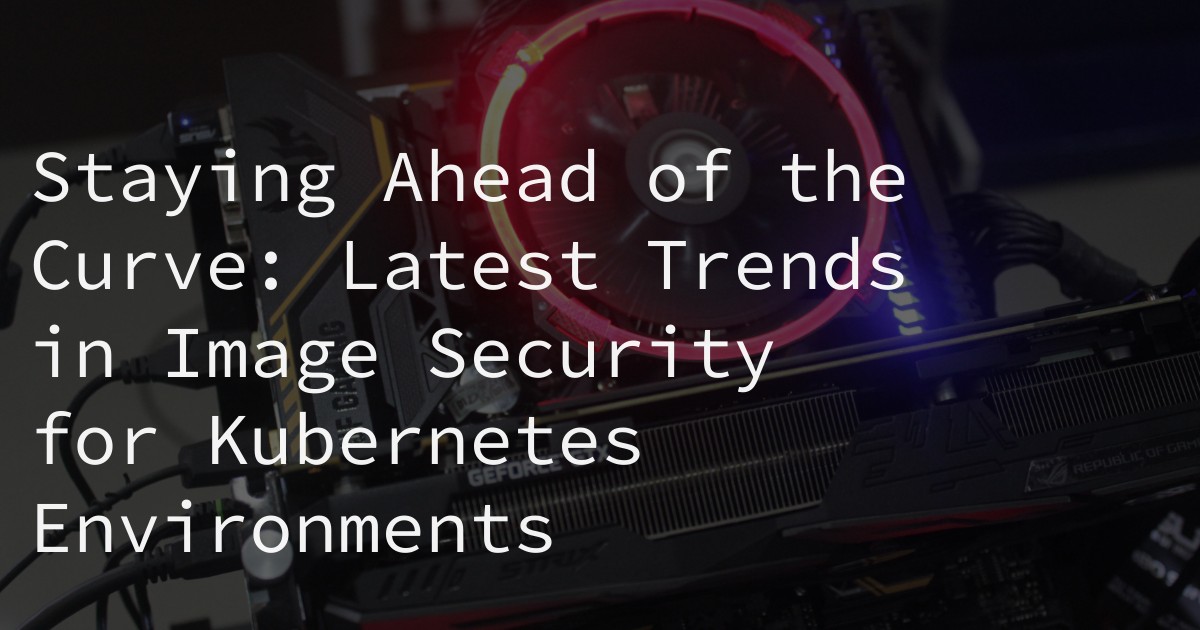
16 Nov Staying Ahead of the Curve: Latest Trends in Image Security for Kubernetes Environments
Kubernetes has become the go-to platform for managing and deploying containerized applications in the cloud. With its ability to automate and scale applications, it has revolutionized the way organizations manage their workloads. However, with this increased adoption of Kubernetes, comes the need for robust security measures to protect the environment and its resources. One crucial aspect of Kubernetes security is image security, which involves securing the images used in Kubernetes clusters. In this article, we will discuss the latest trends and tools for image security in Kubernetes environments, and how organizations can stay ahead of the curve in securing their clusters.
Introduction
Kubernetes is an open-source container orchestration platform that allows organizations to deploy, manage, and scale containerized applications in the cloud. It provides a highly flexible and scalable infrastructure for running applications, making it a popular choice for modern software development. However, with the increasing use of Kubernetes, comes the need for robust security measures to protect the environment and its resources.
One crucial aspect of Kubernetes security is image security, which involves securing the images used in Kubernetes clusters. Images are the building blocks of containers, and they contain the application code, dependencies, and configurations. Therefore, securing these images is essential to ensure the overall security of the Kubernetes environment.
In this article, we will discuss the latest trends and tools for image security in Kubernetes environments, and how organizations can stay ahead of the curve in securing their clusters.
Challenges in Securing Kubernetes Clusters
Securing Kubernetes clusters can be a challenging task for organizations due to various factors. Some of the key challenges include:
- Complexity of managing and securing multiple clusters
- Vulnerabilities in open-source software used in Kubernetes
- Risks associated with using third-party images
- Lack of built-in security features in Kubernetes
These challenges make it crucial for organizations to have a robust image security strategy in place to protect their Kubernetes clusters from potential threats.
Image Security in Kubernetes
Image security plays a vital role in the overall security of a Kubernetes environment. A compromised image can lead to a compromised cluster, making it essential to have proper image security measures in place. Some of the key reasons why image security is crucial in Kubernetes include:
- Impact of image vulnerabilities on a Kubernetes environment
- Role of image security in overall Kubernetes security
- Benefits of using secure images in Kubernetes
By securing images, organizations can prevent potential attacks and ensure the integrity and availability of their applications running on Kubernetes clusters.
Latest Developments and Trends in Image Security for Kubernetes
As organizations continue to adopt Kubernetes for their containerized applications, the need for robust image security measures has become more critical. To meet this demand, there have been several developments and trends in image security for Kubernetes, including:
- Increase in the use of container registries and image scanners for security
- Adoption of automated image scanning and vulnerability management tools
- Emphasis on container hardening and image signing
- Integration of image security into CI/CD pipelines
These developments and trends have made it easier for organizations to secure their images in Kubernetes and stay ahead of potential threats.
Tools for Securing Images in a Kubernetes Environment
There are various tools available for securing images in a Kubernetes environment. Some of the popular tools include:
- Container registries such as Docker Hub, Google Container Registry, and Amazon Elastic Container Registry (ECR)
- Image scanning and vulnerability management tools like Clair, Twistlock, and Aqua Security
- Image signing and verification tools like Notary and Sigstore
When choosing an image security tool for a Kubernetes environment, organizations should consider factors such as cost, ease of use, and integration with their existing infrastructure.
Best Practices for Securing Images in Kubernetes
To ensure the security of images in a Kubernetes environment, organizations should follow best practices such as:
- Guidelines for creating secure container images
- Implementing image signing and verification
- Regularly scanning and updating images for vulnerabilities
- Using a registry policy to control image usage
By following these best practices, organizations can minimize the risk of potential attacks and ensure the security of their Kubernetes clusters.
Real-World Examples of Image Security in Kubernetes Setups
Many organizations have already implemented image security measures in their Kubernetes environments. Some real-world examples include:
- Case studies of organizations implementing image security in their Kubernetes environments
- Challenges faced and solutions implemented
- Lessons learned and best practices for image security in Kubernetes
By learning from these real-world examples, organizations can gain insights into the best practices and challenges of implementing image security in Kubernetes.
Conclusion
Image security is a crucial aspect of securing Kubernetes environments. By following the latest trends and using the right tools, organizations can stay ahead of potential threats and ensure the security of their clusters. It is essential for organizations to have a robust image security strategy in place to protect their Kubernetes clusters and maintain the integrity and availability of their applications.
In this article, we discussed the importance of image security in Kubernetes, the challenges in securing Kubernetes clusters, and the latest trends and tools for image security. We also highlighted best practices and real-world examples of image security in Kubernetes setups. By implementing these measures, organizations can stay ahead of the curve and ensure the security of their Kubernetes environments.
RELATED ARTICLES:



Sorry, the comment form is closed at this time.